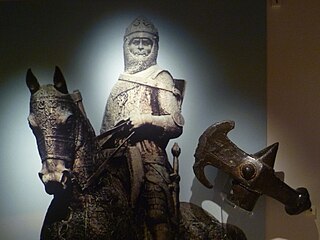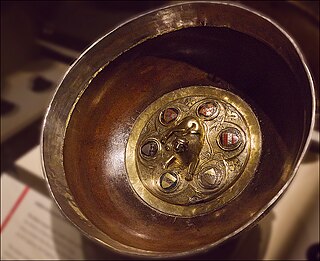 W
WAlloa Tower in Alloa, Clackmannanshire in central Scotland is an early 14th century tower house that served as the medieval residence of the Erskine family, later Earls of Mar. Retaining its original timber roof and battlements, the tower is one of the earliest, and largest, of Scottish tower houses, with immensely thick walls. It was designated as a scheduled monument in 1960 and is now owned by the National Trust for Scotland.
 W
WBruce's Cave or the Dunskellie Grotto is a relatively small and mainly artificial cave created in the red sandstone cliffs about 9 metres above the Kirtle Water at Cove, Kirkpatrick-Fleming, Dumfries and Galloway, Scotland. It has been associated with Robert the Bruce and the famous incident with the spider struggling to build its web.
 W
WThe Brus, also known as The Bruce, is a long narrative poem, in Early Scots, of just under 14,000 octosyllabic lines composed by John Barbour which gives a historic and chivalric account of the actions of Robert the Bruce and Sir James Douglas in the Scottish Wars of Independence during a period from the circumstances leading up to the English invasion of 1296 through to Scotland's restored position in the years between the Treaty of 1328 and the death of Thomas Randolph, Earl of Moray in 1332.
 W
WThe Bute Mazer, also known as the Bannatyne Mazer is a medieval communal feasting cup of a type known as a mazer. The wood bowl and the elaborate silver-gilt "boss" in the centre are dated "fairly firmly" to between 1314 and 1327 from the heraldry, with the rim and cover about 1500. It is the oldest Scottish mazer still surviving, and one of the oldest and most elaborate British ones. The cup has long been associated with the Isle of Bute, on the west coast of Scotland. Its alternative name derives from Ninian Bannatyne, Laird of Kames, who owned the cup in the 16th century and had his name engraved on the rim. The mazer is now on loan from the Bannatyne family to the National Museum of Scotland in Edinburgh.
 W
WFetteresso Castle is a 14th-century tower house, rebuilt in 1761 as a Scottish Gothic style Palladian manor, with clear evidence of prehistoric use of the site. It is situated immediately west of the town of Stonehaven in Kincardineshire, slightly to the west of the A90 dual carriageway. Other notable historic fortified houses or castles in this region are Dunnottar Castle, Muchalls Castle, Fiddes Castle, Cowie Castle and Monboddo House.
 W
WChâteau Gaillard is a medieval castle ruin overlooking the River Seine above the commune of Les Andelys, in the French department of Eure, in Normandy. It is located some 95 kilometres (59 mi) north-west of Paris and 40 kilometres (25 mi) from Rouen. Construction began in 1196 under the auspices of Richard the Lionheart, who was simultaneously King of England and feudal Duke of Normandy. The castle was expensive to build, but the majority of the work was done in an unusually short period of time. It took just two years and, at the same time, the town of Petit Andely was constructed. Château Gaillard has a complex and advanced design, and uses early principles of concentric fortification; it was also one of the earliest European castles to use machicolations. The castle consists of three enclosures separated by dry moats, with a keep in the inner enclosure.
 W
WThe Old Tolbooth was an important municipal building in the city of Edinburgh, Scotland for more than 400 years. The medieval structure, which was located at the northwest corner of St Giles' Cathedral and was attached to the west end of the Luckenbooths on the High Street in the Old Town, was first established in the 14th century by royal charter. Over the years it served a variety of purposes such as housing the Burgh Council, early meetings of the Parliament of Scotland and the Court of Session. The Tolbooth was also the burgh's main jail where, in addition to incarceration, physical punishment and torture were routinely conducted. From 1785 public executions were carried out. In 1817 the buildings, which had been rebuilt and renovated several times, were demolished.
 W
WThe Regiam Majestatem is the earliest surviving work giving a comprehensive digest of the Law of Scotland. The name of the document is derived from its first two words. It consists of four books, treating (1) civil actions and jurisdictions, (2) judgments and executions, (3) contracts, and (4) crimes.
Scottish Marches was the term used for the Anglo-Scottish border during the late medieval and early modern eras, characterised by violence and cross-border raids. The Scottish Marches era came to an end during the first decade of the 17th century following the union of the crowns of England and Scotland.
 W
WThe First War of Scottish Independence was the first of a series of wars between English and Scottish forces. It lasted from the English invasion of Scotland in 1296 until the de jure restoration of Scottish independence with the Treaty of Edinburgh–Northampton in 1328. De facto independence was established in 1314 at the Battle of Bannockburn. The wars were caused by English kings attempting to establish their authority over Scotland while Scots fought to keep English rule and authority out of Scotland.
 W
WThe Wars of Scottish Independence were a series of military campaigns fought between the Kingdom of Scotland and the Kingdom of England in the late 13th and early 14th centuries.